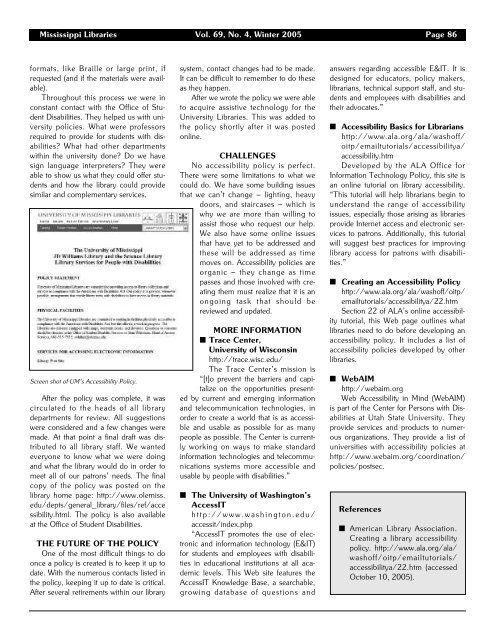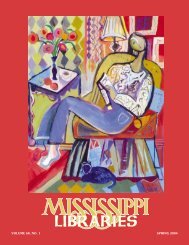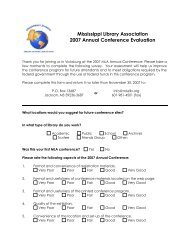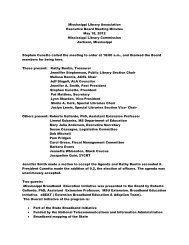Full Text (PDF) - Mississippi Library Association
Full Text (PDF) - Mississippi Library Association
Full Text (PDF) - Mississippi Library Association
Create successful ePaper yourself
Turn your PDF publications into a flip-book with our unique Google optimized e-Paper software.
<strong>Mississippi</strong> Libraries Vol. 69, No. 4, Winter 2005 Page 86<br />
formats, like Braille or large print, if<br />
requested (and if the materials were available).<br />
Throughout this process we were in<br />
constant contact with the Office of Student<br />
Disabilities. They helped us with university<br />
policies. What were professors<br />
required to provide for students with disabilities?<br />
What had other departments<br />
within the university done? Do we have<br />
sign language interpreters? They were<br />
able to show us what they could offer students<br />
and how the library could provide<br />
similar and complementary services.<br />
Screen shot of UM’s Accessibility Policy.<br />
After the policy was complete, it was<br />
circulated to the heads of all library<br />
departments for review. All suggestions<br />
were considered and a few changes were<br />
made. At that point a final draft was distributed<br />
to all library staff. We wanted<br />
everyone to know what we were doing<br />
and what the library would do in order to<br />
meet all of our patrons’ needs. The final<br />
copy of the policy was posted on the<br />
library home page: http://www.olemiss.<br />
edu/depts/general_library/files/ref/acce<br />
ssibility.html. The policy is also available<br />
at the Office of Student Disabilities.<br />
THE FUTURE OF THE POLICY<br />
One of the most difficult things to do<br />
once a policy is created is to keep it up to<br />
date. With the numerous contacts listed in<br />
the policy, keeping it up to date is critical.<br />
After several retirements within our library<br />
system, contact changes had to be made.<br />
It can be difficult to remember to do these<br />
as they happen.<br />
After we wrote the policy we were able<br />
to acquire assistive technology for the<br />
University Libraries. This was added to<br />
the policy shortly after it was posted<br />
online.<br />
CHALLENGES<br />
No accessibility policy is perfect.<br />
There were some limitations to what we<br />
could do. We have some building issues<br />
that we can’t change – lighting, heavy<br />
doors, and staircases – which is<br />
why we are more than willing to<br />
assist those who request our help.<br />
We also have some online issues<br />
that have yet to be addressed and<br />
these will be addressed as time<br />
moves on. Accessibility policies are<br />
organic – they change as time<br />
passes and those involved with creating<br />
them must realize that it is an<br />
ongoing task that should be<br />
reviewed and updated.<br />
MORE INFORMATION<br />
■ Trace Center,<br />
University of Wisconsin<br />
http://trace.wisc.edu/<br />
The Trace Center’s mission is<br />
“[t]o prevent the barriers and capitalize<br />
on the opportunities presented<br />
by current and emerging information<br />
and telecommunication technologies, in<br />
order to create a world that is as accessible<br />
and usable as possible for as many<br />
people as possible. The Center is currently<br />
working on ways to make standard<br />
information technologies and telecommunications<br />
systems more accessible and<br />
usable by people with disabilities.”<br />
■ The University of Washington’s<br />
AccessIT<br />
http://www.washington.edu/<br />
accessit/index.php<br />
“AccessIT promotes the use of electronic<br />
and information technology (E&IT)<br />
for students and employees with disabilities<br />
in educational institutions at all academic<br />
levels. This Web site features the<br />
AccessIT Knowledge Base, a searchable,<br />
growing database of questions and<br />
answers regarding accessible E&IT. It is<br />
designed for educators, policy makers,<br />
librarians, technical support staff, and students<br />
and employees with disabilities and<br />
their advocates.”<br />
■ Accessibility Basics for Librarians<br />
http://www.ala.org/ala/washoff/<br />
oitp/emailtutorials/accessibilitya/<br />
accessibility.htm<br />
Developed by the ALA Office for<br />
Information Technology Policy, this site is<br />
an online tutorial on library accessibility.<br />
“This tutorial will help librarians begin to<br />
understand the range of accessibility<br />
issues, especially those arising as libraries<br />
provide Internet access and electronic services<br />
to patrons. Additionally, this tutorial<br />
will suggest best practices for improving<br />
library access for patrons with disabilities.”<br />
■ Creating an Accessibility Policy<br />
http://www.ala.org/ala/washoff/oitp/<br />
emailtutorials/accessibilitya/22.htm<br />
Section 22 of ALA’s online accessibility<br />
tutorial, this Web page outlines what<br />
libraries need to do before developing an<br />
accessibility policy. It includes a list of<br />
accessibility policies developed by other<br />
libraries.<br />
■ WebAIM<br />
http://webaim.org<br />
Web Accessibility in Mind (WebAIM)<br />
is part of the Center for Persons with Disabilities<br />
at Utah State University. They<br />
provide services and products to numerous<br />
organizations. They provide a list of<br />
universities with accessibility policies at<br />
http://www.webaim.org/coordination/<br />
policies/postsec.<br />
References<br />
■ American <strong>Library</strong> <strong>Association</strong>.<br />
Creating a library accessibility<br />
policy. http://www.ala.org/ala/<br />
washoff/oitp/emailtutorials/<br />
accessibilitya/22.htm (accessed<br />
October 10, 2005).














